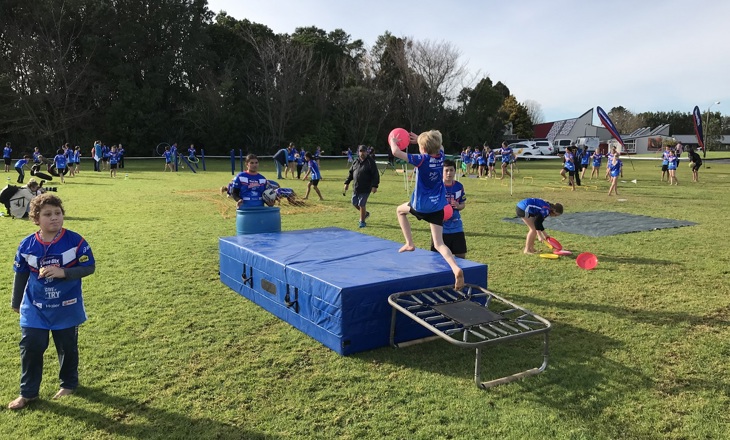Re-thinking traditional school sport events in Taranaki
Re-thinking traditional school sport events in Taranaki

Primary and intermediate schools across Taranaki are being supported through Healthy Active Learning to re-think their approach to traditional physical activity events and seeing more students engaged and enjoying themselves as a result. Sport Taranaki Healthy Active Learning Lead Chris McLean explains how, and why.
It is not uncommon for a school calendar in Aotearoa to consist of swimming sports, cross country, and athletics, with learning focused on ‘readying’ ākonga for these events and then identifying the top athletes to represent the school at the next stage.
Unfortunately, this can sometimes result in ākonga sitting in a line waiting their turn, or simply doing laps around the field. Hardly a quality physical activity experience for the participant, or non-participant if students turn up to school with a note to excuse them from the experience altogether.
Keeping this in mind, the wero is set. How do we cater for all? How do we make sure we are being inclusive of all abilities? How do we instill a lifelong love of learning and moving within our tamariki for the purpose of wellbeing? How do we create quality experiences where ākonga are challenged within a safe environment?
Ākonga at the centre
For Westown School health and physical education lead Paul Tattersall, putting students at the centre was key to change.
As a result of attending Healthy Active Learning workshops and receiving follow-up support, Paul had a real “flip in mindset” and saw an “opportunity to get creative in offering a different experience”.
Paul started by asking students for their views on cross country in its current state – an event in which 40 percent of the school did not participate.
Empowering his student leaders through a tuakana teina approach, ākonga then designed activities which aimed to engage the whole school community. The event saw multilevel school groups taken through a range of activity stations, moving alongside whānau to the musical beats delivered by teacher aide DJ, while local police cooked on the barbecue, culminating in a flurry of coloured powder through the final channel.
Meanwhile, at Huirangi School, events continue to grow and develop in response to student wants, needs, and experiences. After seeing how small-sided games led to higher participation and enjoyment, junior teacher Danita Drinkwater immediately introduced a number of these games as part of the school’s traditional athletics day rotations. On event day, Danita knew they were onto something good. Previously ākonga would have lined up behind the long jump pit for one of their three turns. They were now moving, jumping, and laughing.
Fast forward to the following year, senior teacher Ana Southee thought her students could have a role in creating an inclusive, student-led event. Using Strand D: Healthy Communities and Environments to guide the learning, and specifically, the Achievement Objective; Plan and implement a programme to enhance an identified social or physical aspect of their classroom or school environment, the Year 5 and 6 students designed games and activities with a ‘run, jump, throw’ focus. They trialed them first with the junior students as part of their learning programmes, before refining them to then implement on the day.
“It couldn’t have gone better. The senior students did such a great job planning and then running the event. We will be re-thinking all our school events from now,” says Ana.

A change of thinking
Student input was also a successful ingredient for Manukorihi Intermediate in shaping a Sanitarium TRY-Challenge event as the host school.
Student leaders saw it as an opportunity to provide the intermediate’s contributing schools with a ‘taste of Manukorihi’.
Whilst SMC Events provided the bells and whistles with their inflatable obstacle course, students designed additional ‘tough kid’ style aspects of the course, while tabloid activities were run by community icon Kevin Bennett as part of a huge community event with a meaningful purpose.
Principal Fiona Low said the success of the event had inspired a Colour Run the following term.
“It was awesome to see students who are usually less enthusiastic about participating in physical activity absolutely giving it their all, doing as many laps of the course as they could, being active and having fun.”
For other schools across the region, further exposure to the curriculum has led to a change of thinking and design of learning programmes within health and physical education.
Some are realising the impact that movement activities, using the same pedagogical strategies they use across other learning areas, can have on engagement and are moving away from simply ‘readying’ their students for the events.
They are being more responsive to the strengths and needs of ākonga by utilising the full breadth and depth of the curriculum and looking for opportunities to learn ‘through movement’.
While traditional events can provide an opportunity for a select few to shine, the whakataukī gifted to the learning area of health and physical education, ‘He oranga ngākau, he pikinga waiora – Positive feelings in your heart will enhance your sense of self-worth’, is a fantastic reminder that every learner should be able to find their sense of belonging and self-worth.
The support of the Healthy Active Learning team at Sport Taranaki is showing that when teachers and school leaders are given the guidance, time, and space to explore health and physical education, they understand its intention: to improve the wellbeing of the individual, other people, and wider society.
This article was originally published in the Education Gazette.
